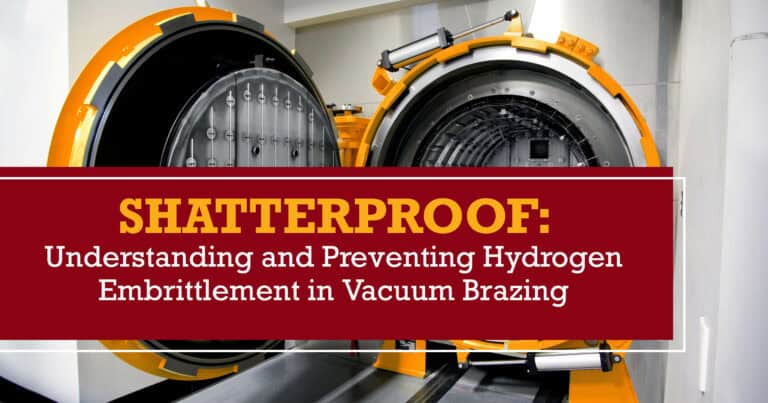Hydrogen embrittlement is a silent killer in the world of vacuum brazing. It’s a microscopic menace that can turn your high-strength alloys into brittle failures waiting to happen. Durable goods manufacturers: You can’t afford to ignore this problem, so we’ll get straight to the facts.
The Heart of the Matter: Hydrogen Embrittlement 101
Hydrogen embrittlement occurs when atomic hydrogen infiltrates the crystalline structure of metals, particularly high-strength alloys. In vacuum brazing, this sneaky intruder can come from multiple sources that include:
- Residual moisture in the vacuum chamber.
- Hydrocarbon contaminants on part surfaces.
- Hydrogen-containing brazing filler metals.
Once inside, these nasty hydrogen atoms congregate at grain boundaries and dislocations, creating a firestorm of woes, including:
- Reduced ductility.
- Decreased tensile strength.
- Increased susceptibility to cracks and crack propagation.
The result? Catastrophic failure of your brazed components, often under normal operating conditions and without warning!
The Downside for Durable Goods Manufacturers
We’re not about to sugarcoat this. Hydrogen embrittlement is bad news for your bottom line because it can lead to these and other headaches:
- Product Failures: Components can fail prematurely, leading to costly recalls and reputation damage.
- Increased Warranty Claims: When products fail, you foot the bill.
- Production Delays: Identifying and rectifying hydrogen embrittlement issues can halt your production line.
- Material Waste: Embrittled parts are scrap—plain and simple.
- Liability Risks: In critical applications, component failure can lead to serious accidents and legal nightmares.
- Loss of Market Share: Competitors with better control over hydrogen embrittlement will eat your lunch.
Prevention: Your Hydrogen Embrittlement Battle Plan
The upside is you can avoid this. Preventing hydrogen embrittlement in vacuum brazing isn’t rocket science, but it does require rigorous attention to important details. Here’s a checklist for what needs to be done in each essential step of the process:
1. Pre-Brazing Surface Preparation
- Degrease parts thoroughly using non-hydrocarbon solvents.
- Implement stringent cleaning protocols to remove all potential hydrogen sources.
- Consider using vapor degreasing or ultrasonic cleaning for complex geometries.
2. Vacuum System Optimization
- Maintain a high-quality vacuum (1×10^-5 Torr or better) throughout the brazing cycle.
- Use multiple-stage pumping systems to efficiently remove hydrogen-containing gases.
- Regularly leak-check your vacuum system to prevent atmospheric contamination.
3. Filler Metal Selection
- Choose low-hydrogen brazing filler metals whenever possible.
- When using hydrogen-containing fillers, implement proper outgassing procedures.
- Consider amorphous brazing foils, which typically have lower hydrogen content.
4. Process Parameter Control
- Optimize heating and cooling rates to minimize hydrogen absorption and diffusion.
- Implement proper hold times at the brazing temperature to allow hydrogen outgassing.
- Use temperature uniformity surveys to ensure consistent heating across all parts.
5. Post-Braze Heat Treatment
- Perform hydrogen bake-out treatments immediately after brazing.
- Implement stress-relief heat treatments to reduce residual stresses that can exacerbate embrittlement.
6. Quality Control and Testing
- Perform routine mechanical testing (tensile, bend, impact, etc.) to detect embrittlement.
- Use a technique like LECO combustion analysis to quantify residual hydrogen.
- Consider nondestructive testing methods like acoustic emission for in situ monitoring.
Avoid the Serious Threat
Hydrogen embrittlement in vacuum brazing is a serious threat, but it’s not an insurmountable one. By working with experts who know how to implement rigorous control measures, this microscopic menace can be kept at bay. Remember, in the world of high-performance durable goods manufacturing, there’s no room for weak links. Don’t let hydrogen embrittlement shatter your success. Take action now and work with experts who are at the top of their game.

